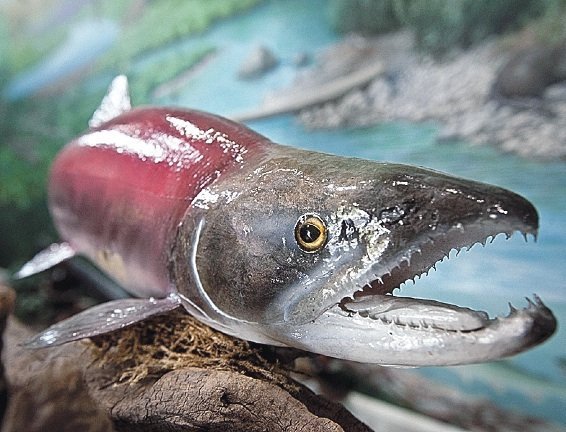forum
library
tutorial
contact

New $13 Million Snake River
Sockeye Hatchery Opens
by Staff
Columbia Basin Bulletin, September 13, 2013
|
the film forum library tutorial contact |

|
New $13 Million Snake River
by Staff
|
Goal is Recolonization in Sawtooth Basin
 About 150 state, federal and tribal officials and several local neighbors, gathered Friday, Sept. 6, to mark the completion of the new Springfield Hatchery.
About 150 state, federal and tribal officials and several local neighbors, gathered Friday, Sept. 6, to mark the completion of the new Springfield Hatchery.
The $13.5 million facility will be capable of producing up to 1 million juvenile Snake River sockeye salmon annually for release in the Sawtooth Basin of central Idaho, the headwaters of the Salmon River.
This additional capacity will lift the sockeye recovery effort from the conservation phase to a re-colonization phase where emphasis will be on returning increasing numbers of ocean-run adults to use in hatchery spawning and to release to the natural habitat to spawn.
The increase in adult fish may eventually mean recreational and tribal fishing seasons on Snake River sockeye.
The hatchery is funded by the Bonneville Power Administration as part of its obligation to mitigate the impact of hydropower dams on salmon and steelhead.
The current run of sockeye into the Snake River is one of three remaining populations in the Columbia River Basin. The other two populations are in Okanogan and Wenatchee lakes, on tributaries of the upper Columbia River.
Partners in the sockeye recovery effort include Idaho, Oregon, Washington, NOAA-Fisheries, the Shoshone-Bannock Tribe, BPA nd the Northwest Power and Conservation Council.
The facility, which sits on 73 acres, will be operated by the Idaho Department of Fish and Game.
"The story of the Snake River sockeye is one of perseverance: Their numbers were once so depressed by harvest, predation, habitat loss and dams that many in the scientific community declared them functionally extinct," said Lorri Bodi, vice president of Environment, Fish & Wildlife for the Bonneville Power Administration. "But these fish are survivors, and the state of Idaho, BPA, Shoshone-Bannock Tribes and other stakeholders weren't willing to give up on improving conditions for these fish. The Springfield Hatchery is just one piece of a larger effort that has proven successful in bringing back the Snake River sockeye."
The Snake River sockeye was listed as an endangered species in November of 1991. In May of that year, the Snake River Sockeye Captive Broodstock Program was established by IDFG, BPA, NOAA Fisheries, Shoshone-Bannock Tribes and the Oregon Department of Fish and Wildlife. The broodstock program sought to preserve the genetic diversity of the species and prevent its extinction.
In 1992, a single male sockeye returned, dubbed Lonesome Larry by Idaho Gov. Cecil Andrus. In 1995 and again in 1997, the number of adult sockeye returning from the ocean to the Sawtooth Basin dropped to zero. But by 2010, it had reached 1,336, a number not seen since the 1950s.
As for this year, 738 sockeye have been counted at Lower Granite Dam so far.
The IDFG through midweek had trapped in central Idaho's Sawtooth Basin, either at Redfish Lake Creek or Sawtooth Hatchery, 257 adult sockeye spawners returning from the Pacific Ocean, with roughly 40 males and 40 females expected to be used to help fuel the new hatchery, along with hatchery reared broodstock that has been grown at the IDFG's Eagle Hatchery near Boise and NOAA Fisheries' facilities in western Washington.
The return is less than hoped, given a "conversion rate" of about 35 percent, compared to 60 to 70 percent in recent years. That conversion rate is the percentage of fish that survive the 400 miles or so from the lower Snake River's Lower Granite Dam up the Salmon River to the sockeye spawning grounds. Low flows, and warmer than desired conditions in the Salmon River, are believed to have pushed down survival rates.
The creation of the Springfield Fish Hatchery, in Bingham County, now allows the program to focus on increasing smolt production to assist in large returns of ocean-run adult sockeye to the Stanley Basin in Idaho. The adults will be used in hatchery spawning as well as released to natural habitat to spawn.
"This is a great example of how constructive collaboration can work -- work for the species and work for the people we serve," Gov. C.L. "Butch" Otter said. "Idaho has a lot of aquaculture expertise, and using hatcheries like this to help boost the runs is a smart investment."
"Opening this hatchery is a big step toward continuing to bring back Idaho's unique sockeye," Fish and Game Director Virgil Moore said. "With the help and support of our partners in this effort, we look forward to the day when we can set a sockeye season for Idaho's tribal and recreational anglers."
The hatchery was designed and constructed by the Idaho-based engineering firm of McMillen LLC. The water supply for the Springfield facility is more than 50 cubic feet per second of cold, clean spring water -- just right for raising sockeye.
learn more on topics covered in the film
see the video
read the script
learn the songs
discussion forum
